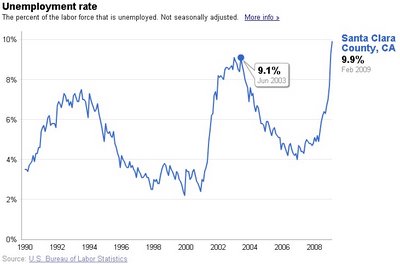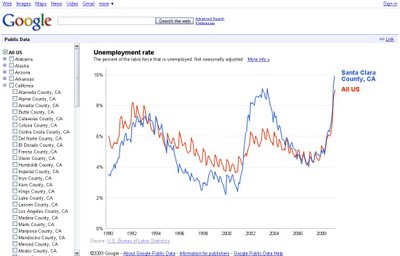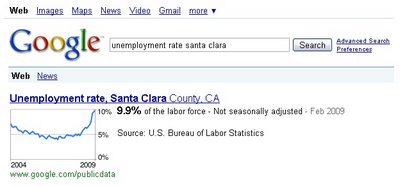Adding search power to public data

We just launched a new search feature that makes it easy to find and compare public data. So for example, when comparing Santa Clara county data to the national unemployment rate, it becomes clear not only that Santa Clara's peak during 2002-2003 was really dramatic, but also that the recent increase is a bit more drastic than the national rate:

If you go to Google.com and type in [unemployment rate] or [population] followed by a U.S. state or county, you will see the most recent estimates:

Once you click the link, you'll go to an interactive chart that lets you add and remove data for different geographical areas.
Here's a video showing how it works:
The data we're including in this first launch represents just a small fraction of all the interesting public data available on the web. There are statistics for prices of cookies, CO2 emissions, asthma frequency, high school graduation rates, bakers' salaries, number of wildfires, and the list goes on. Reliable information about these kinds of things exists thanks to the hard work of data collectors gathering countless survey forms, and of careful statisticians estimating meaningful indicators that make hidden patterns of the world visible to the eye. All the data we've used in this first launch are produced and published by the U.S. Bureau of Labor Statistics and the U.S. Census Bureau's Population Division. They did the hard work! We just made the data a bit easier to find and use.
Since Google's acquisition of Trendalyzer two years ago, we have been working on creating a new service that make lots of data instantly available for intuitive, visual exploration. Today's launch is a first step in that direction. We hope people will find this search feature helpful, whether it's used in the classroom, the boardroom or around the kitchen table. We also hope that this will pave the way for public data to take a more central role in informed public conversations.
This is just the beginning. Stay tuned for more.
Ola Rosling, Product Manager
googleblog.blogspot.com
published @ April 28, 2009